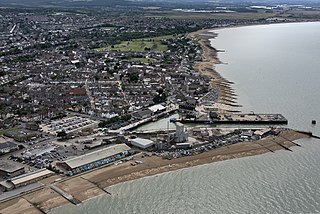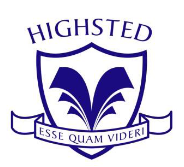
Whitstable is a town on the north coast of Kent adjoining the convergence of the Swale Estuary and the Greater Thames Estuary in southeastern England, five miles north of Canterbury and two miles west of Herne Bay. The 2011 Census reported a population of 32,100.

The Judd School is a voluntary aided grammar school in Tonbridge, Kent, England. It was established in 1888 at Stafford House on East Street in Tonbridge, where it remained for eight years before moving to its present location on Brook Street, in the south of the town. Founded by the Worshipful Company of Skinners, it was named after 16th century merchant Sir Andrew Judde, whose endowment helped fund the school. The Skinners' Company maintains close links with the school and makes up the majority of the governing body.

A secondary modern school is a type of secondary school that existed throughout England, Wales and Northern Ireland from 1944 until the 1970s under the Tripartite System. Schools of this type continue in Northern Ireland, where they are usually referred to as secondary schools, and in areas of England, such as Buckinghamshire, Lincolnshire and Wirral,.
Ripon Grammar School is a co-educational, boarding and day, selective grammar school in Ripon, North Yorkshire, England. It has been named top-performing state school in the north for nine years running by The Sunday Times. It is one of the best-performing schools in the North of England; in 2011, 91% of pupils gained the equivalent of 5 or more GCSEs at grade C or above, including English and maths; the figure has been over 84% consistently since at least 2006. The school was graded "outstanding" in its 2012 Ofsted report. In 2017, the school's boarding was rated 'outstanding' by Ofsted. As a state school, it does not charge fees for pupils to attend, but they must pass an entrance test at 11+ or 13+. There is no selection test for entry into sixth form as pupils are admitted on the basis of their GCSE grades.

Founded by King Henry VIII, The King's School is a state-funded Church of England school located in Peterborough, England.
The grammar schools debate is a debate about the merits and demerits of the existence of grammar schools in the United Kingdom. Grammar schools are state schools which select their pupils on the basis of academic ability, with pupils sitting an exam in the last year of primary school to determine whether or not they gain a place. The debate on selective education has been widened by measures which allow a proportion of students to be chosen based on their "aptitude" for a particular subject.
Graveney School is a secondary school and sixth form with academy status in the Furzedown area of Tooting, southwest London, England. The school has a partially selective admissions policy. At the beginning of 2015 Graveney was assessed in an Ofsted inspection report as outstanding.
Lincolnshire is one of the few counties within the UK that still uses the eleven-plus to decide who may attend grammar school, in common with Buckinghamshire and Kent.

Harrogate High School is a comprehensive secondary school in Harrogate, North Yorkshire, England. It has about 600 pupils on roll and approximately 85 full-time teaching staff. The school was awarded specialist Sports College status. The Academy Head is Mark Turner.
Jubilee High School is a coeducational secondary school with academy status, located in Addlestone, Surrey, England. The school holds Artsmark Gold Award and International School status.

Herne Bay High School is a mixed ability Academy, with designated Sports College status, situated in Herne Bay, Kent, England. There are 1506 students in the school aged 11 to 18. The principal as of March 2022 is Mr Jon Boyes.
Pensnett High School was a secondary school located in the Pensnett area of the Dudley Metropolitan Borough, in the West Midlands of England. There were around 150 pupils aged 14–16 on the school roll before closure.

The Canterbury Academy is a co-educational 11-19 academy school in Canterbury, Kent, England. It is a specialist Sports College and 15% of its 1081 pupils are selected on musical aptitude. The school was founded as a non-selective secondary modern foundation school before gaining academy status in 2010.

Fulston Manor School is a secondary School with academy status in Sittingbourne, Kent. The head teacher is Mrs Susie Burden. It teaches years 7–13.

Highsted Grammar School is a state-funded selective secondary school for girls in Sittingbourne, Kent.
The Dover Christ Church Academy, previously known as Archers Court Secondary School is a coeducational secondary school and sixth form located in Whitfield, Kent, 4 miles north of Dover. It has academy status and sponsored by Canterbury Christ Church University.
The Spires Academy is a non-selective secondary school for pupils aged 11–16 in Canterbury, Kent. There is a sixth form. The school has dual specialist status in business and enterprise, and in visual, creative and performing arts. Spires is independently governed, but funded by the sponsors and the Department for Children, Schools and Families. As a non-selective school the school does not insist on prospective pupils passing the eleven-plus examination for entry, and it is free to attend. The Academy is subject, like other schools, to regular inspections, but is managed by an ‘Academy Trust’ called E21C, rather than a local education authority. According to Ofsted inspectors, boys do worse at maths at the school, and generally the school needs to improve (academically).

The Charles Dickens School is a co-educational secondary modern school located in Broadstairs in the English county of Kent. The school is named after Charles Dickens, the 19th-century writer and social critic. It is one of six non-selective schools on the Isle of Thanet, physically isolated corner of Kent.

A comprehensive school, or simply a comprehensive, typically describes a secondary school for pupils aged approximately 11–18, that does not select its intake on the basis of academic achievement or aptitude, in contrast to a selective school system where admission is restricted on the basis of selection criteria, usually academic performance. In England and Wales comprehensive schools were introduced as state schools on an experimental basis in the 1940s and became more widespread from 1965. They may be part of a local education authority or be a self governing academy or part of a multi-academy trust.
St Edmund's Catholic School is a co-educational Roman Catholic secondary school located in Dover, Kent, England. The school is named after Edmund of Abingdon, and is under the jurisdiction of the Roman Catholic Archdiocese of Southwark.











